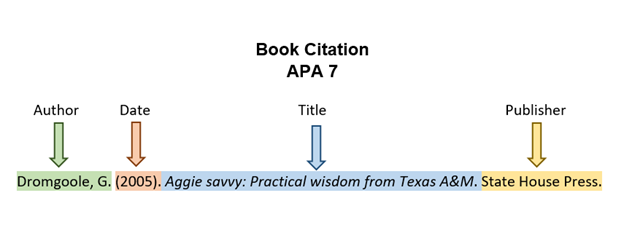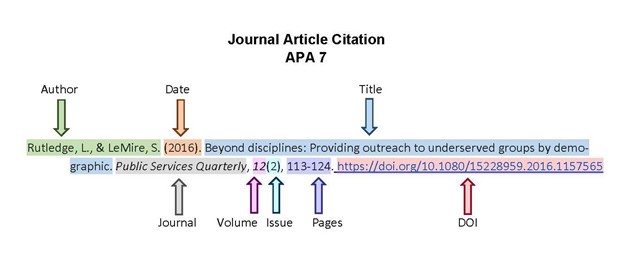12 – Avoiding Plagiarism and Citing Sources Properly
APA Format Quick Reference
Sarah LeMire; Nicole Hagstrom-Schmidt; Kalani Pattison; Matt McKinney; Deborah Bernnard; Greg Bobish; Jenna Hecker; Irina Holden; Allison Hosier; Trudi Jacobson; Tor Loney; and Daryl Bullis
Properly formatted APA citations include two main elements: the reference list entry and the in-text citation. Below you will find sample citations for a variety of commonly-used reference types. For additional questions, consult the Publication Manual of the American Psychological Association (7th ed.)[1]
Reference List
The reference list is found at the end of your document, and it includes all of the sources used when developing your paper or project. References are listed in alphabetical order by the author’s last name, and each reference will have a hanging indent to make it easier to visually distinguish between each reference.
No Author
If there is no author, the title moves into the place of the author. The reference should then be alphabetized by the first word in the title within the reference list. If the first word is an article (“a,” “an,” or “the”), alphabetize according to the second word. If the first word is a number, alphabetize according to the spelling of the number. (For example, if the first word is “665,” you would alphabetize it as if it were “six-hundred and sixty-five.”
Example
Down the Line. (1895). In The Olio: An Annual (pp. 54-58). The Corps of Cadets of the Agricultural and Mechanical College of Texas.
Single Author
In APA style, when there is a single author, you should list them with the last name first, followed by the first and (if available) middle initial.
Example
Clark, D. T. (2009). Lending Kindle e-book readers: First results from the Texas A&M University project. Collection Building, 28(4), 146-149. https://doi.org/10.1108/01604950910999774
Two Authors
When there are two authors, list both and connect them with an ampersand (&). Be sure to keep the authors in the order in which they appear on the source.
Example
Rutledge, L., & LeMire, S. (2016). Beyond disciplines: Providing outreach to underserved groups by demographic. Public Services Quarterly, 12(2), 113–124. https://doi.org/10.1080/15228959.2016.1157565
Three to Twenty Authors
When there are between three and twenty authors, list each one and use an ampersand (&) before the final author. Be sure to keep the authors in the order in which they appear on the source.
Example
LeMire, S., Graves, S. J., Hawkins, M., & Kailani, S. (2018). Libr-AR-y Tours: Increasing engagement and scalability of library tours using augmented reality. College & Undergraduate Libraries, 25(3), 261–279. https://doi.org/10.1080/10691316.2018.1480445
Twenty-One or More Authors
When there are more than twenty authors, list the first nineteen authors, then add an ellipsis (…) and the last author’s name. The ellipsis (…) will take the place of author names between author number nineteen and the final author. Be sure to keep the authors in the order in which they appear on the source.
Example
Agnese, R., Anderson, A. J., Asai, M., Balakishiyeva, D., Thakur, R. B., Bauer, D. A., Beaty, J., Billard, J., Borgland, A, Bowles, M.A., Brandt, D., Brink, P.L., Bunker, R., Cabrera, B., Caldwell, D.O., Cerdeno, D.G., Chagani, H., Chen, Y., Cherry, M., … Zhang, J. (2014). Search for low-mass weakly interacting massive particles with SuperCDMS. Physical Review Letters, 112(24), 241–302. https://doi.org/10.1103/PhysRevLett.112.241302
Institutional Author
Sometimes the author isn’t a person—instead, the source is authored by an organization. In this case, you’ll list the organization as the author.
Example
Texas A&M University. (2019). Aggie traditions. https://www.tamu.edu/traditions/index.html
Book
Books list the author, followed by the year, and then the title in italics. The title is in sentence case, which means that you only capitalize the first word, any proper nouns or adjectives, and the first word after a colon or period. APA also includes the publisher name. If the book is accessed electronically, also include the digital object identifier (doi). Figure 12.1[2] illustrates the components of a book citation in APA format.
Example

Article from a Database
Articles from online databases like Google Scholar or EBSCO include the author names, year of publication, and article title in sentence case. For the journal title, follow the capitalization provided by the journal itself. The journal title and the volume number are in italics. The issue is in parentheses, followed by the page range.
To help the reader access the article, always include the doi (permanent url) if one is available. It is generally listed near the top of the article. It may appear as doi: or https://dx.doi.org/ followed by a sequence of numbers and/or letters. The doi number typically starts with the number 10, as in the example below. If there is a doi available, include it in your citation using the format https://doi.org/[insert doi number]. Figure 12.2[3] illustrates the components of a journal article citation in APA format.
Example

Newspaper Article
If a newspaper article is found in a database such as Newspaper Source or Access World News, do not include the database name or URL. If the article is found through the open web, include the URL.
If an article is from an online newspaper (for example, Washington Post, New York Times, Wall Street Journal), italicize the name of the newspaper. If the article is from an online news website (e.g. BBC News, CNN, Reuters), italicize the name of the article and not the site.
Example from an online newspaper
Boren, C. (2018, November 25). It took seven overtimes for Texas A&M to beat LSU in the craziest college football game of the year. Washington Post. https://www.washingtonpost.com/sports/ 2018/11/25/it-took-seven-overtimes-texas-am-beat-lsu-craziest-college-football-game-year/
Example from an online news website
Holcombe, M. (2019, July 18). Texas A&M’s new program opens the door to college education for students with disabilities. CNN. https://www.cnn.com/2019/07/18/us/texas-am-program- disabilities/index.html
Website
Example
Texas A&M University Division of Student Affairs. (2019). Residence life. https://reslife.tamu.edu/
YouTube Video
Example
Texas A&M University. (2019, September 8). Fearless on every front [Video]. YouTube. https://www.youtube.com/watch?v=YlRup0e8kTk
Interview
In APA format, an unpublished interview is not included in the reference list. This is because the interview is not available for the reader to view. Instead, interviews are cited only in-text.
Lecture
In APA format, if you are citing your professor’s lecture slides or content, you should point the reader to a digital copy of that content if possible. If housed in a course management system, direct the reader to the login page for that system.
Example
Pantuso, T. (2019, September 10). Visual rhetoric [PowerPoint slides]. eCampus. https://ecampus.tamu.edu/
In-Text Citations
APA in-text citations use the last name(s) of the author(s), followed by a comma and the year of publication. If using a direct quotation, also include the page number where that quotation can be found. The abbreviation “p.” precedes any page numbers. These items are all separated by commas.
In APA format, you can also embed the in-text quotation directly into your sentence (for example, Smith (2001) found that…), which then obviates the need for a parenthetical at the end of the sentence, except in the case of a direct quotation.
No Author
As with the reference list, the in-text citation will use the title if there is no author available. Use the first few words of the title if it is long, and place it in quotation marks.
Example
(“Down the Line,” 1895).
Single Author
If the work has a single author, use the author’s last name, followed by a comma and the year of publication.
Example (no direct quotation)
(Clark, 2009)
Example (direct quotation)
(Clark, 2009, p. 42)
Two Authors
When there are two authors, list the last names of both connected by an ampersand (&). Be sure to keep the authors in the order in which they appear on the source.
Example
(Rutledge & LeMire, 2016).
Three or More Authors
When there are three or more authors, list the first author’s last name, followed by et al. This is a Latin phrase meaning “and others” and used in some citation formats as a way to abbreviate a list of names. Notice that the switch to “et al.” occurs after three authors when using in-text citations. In your References list, you will include up to twenty authors.
Example
(Tribble et al., 2002).
Institutional Author
As with the reference list, you’ll list the organization as the author in the in-text citation.
Example
(Texas A&M University, 2019).
This text was derived from
Deborah Bernnard, Greg Bobish, Jenna Hecker, Irina Holden, Allison Hosier, Trudi Jacobson, Tor Loney, and Daryl Bullis. The Information Literacy User’s Guide: An Open, Online Textbook, edited by Greg Bobish and Trudi Jacobson. Geneseo, NY: Open SUNY Textbooks, Milne Library, 2014. http://textbooks.opensuny.org/the-information-literacy-users-guide-an-open-online-textbook/. Licensed under a Creative Commons Attribution-NonCommercial-ShareAlike 3.0 Unported License.
Pantuso, Terri, and Sarah LeMire and Kathy Anders, eds. Informed Arguments: A Guide to Writing and Research. Rev.2nd ed. College Station, TX: Texas A&M University, 2022. Licensed under a Creative Commons Attribution-NonCommercial-ShareAlike 4.0 International License, except where otherwise noted.
- American Psychological Association, “The Official Guide to APA Style,” Publication Manual of the American Psychological Association, 7th ed. (Washington DC: American Psychological Association, 2019). ↵
- Adapted by Sarah LeMire from Deborah Bernnard, Greg Bobish, Jenna Hecker, Irina Holden, Allison Hosier, Trudi Jacobson, Tor Loney, and Daryl Bullis, The Information Literacy User’s Guide: An Open, Online Textbook, edited by Greg Bobish and Trudi Jacobson (Geneseo, NY: Open SUNY Textbooks, Milne Library, 2014), 56, http://textbooks.opensuny.org/the-information-literacy-users-guide-an-open-online-textbook/. Licensed under a Creative Commons Attribution-NonCommercial-ShareAlike 3.0 Unported License. ↵
- Adapted by Sarah LeMire from Deborah Bernnard, Greg Bobish, Jenna Hecker, Irina Holden, Allison Hosier, Trudi Jacobson, Tor Loney, and Daryl Bullis, The Information Literacy User’s Guide: An Open, Online Textbook, edited by Greg Bobish and Trudi Jacobson (Geneseo, NY: Open SUNY Textbooks, Milne Library, 2014), 57, http://textbooks.opensuny.org/the-information-literacy-users-guide-an-open-online-textbook/. Licensed under a Creative Commons Attribution-NonCommercial-ShareAlike 3.0 Unported License. ↵
Capitalization structure wherein the writer capitalizes only the first word, any proper nouns or adjectives, and the first word after a colon or period.
An assigned alpha-numeric string that uniquely identifies a digital text.
